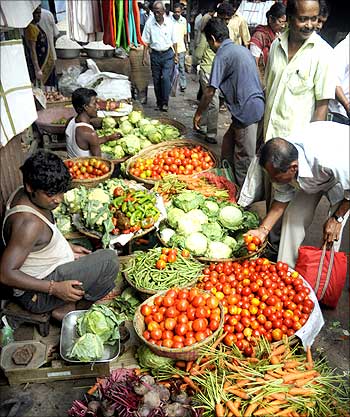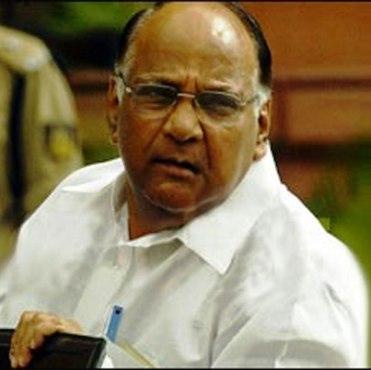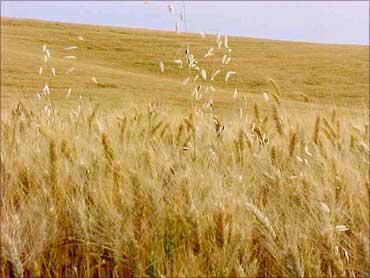 | « Back to article | Print this article |
Food price rise? Here's Pawar's prescription
While the progress of the monsoon has brightened the prospects of foodgrain production, the fall in sown area is a matter of concern, Agriculture Minister Sharad Pawar tells Sanjay Jog.
Pawar also talks about the proposed Food Security Act, which is caught in a debate. Edited excerpts:
Has there been an increase in area under foodgrain production? Has the increase in MSP (minimum support price) encouraged more production?
The area under foodgrain cultivation increased from 120 million hectares in 2004-05 to 124 million hectare in 2007-08.
Thereafter, it declined somewhat, due to vagaries of weather and unprecedented drought in 2009-10.
To make agriculture remunerative on a sustainable basis, a substantial increase in MSP of major cereals, ranging from 39 per cent to 78 per cent, was effected during the last five years.
MSPs of pulses and oilseeds were increased up to 104 per cent during the period. There is no doubt that this has encouraged farmers to produce more. Total foodgrain production has increased from 198.4 million tonnes in 2004-05 to 234.5 mt in 2008-09.
Last year's estimated production of 218.20 mt is to be seen in the backdrop of an unprecedented drought.
However, the various mitigation measures helped reduce the loss to the minimum.
Click NEXT to read further. . .
Food price rise? Here's Pawar's prescription
What's your view on allowing use of GM (genetically modified) seeds in crops other than cotton?
The population of India is expected to reach 1.5 billion by 2025. Providing food and nutritional security to this large population will be the most important social issue.
Food production will have to be doubled.
Conventional technologies are inadequate to meet the formidable challenges of feeding the burgeoning population with limited land and water resources.
In addition, the adverse effects of global climate change impose limitations on crop production.
The biotechnological applications in agriculture, including introduction of GM crops, are a powerful tool to meet the challenge of food and nutritional security.
GM crops have the capability to contribute to productivity, if the varieties developed are pest-resistant, disease-tolerant and biotic and abiotic stress-tolerant.
They could also reduce the production cost.
The government of India has been very supportive of efforts to develop transgenic crops and invested liberally (for this).
A large number of transgenic crops are currently being developed and tested at various public and private institutions.
The country has seen the benefits of Bt cotton, which was grown in more than 80 per cent of the cotton area in the country during 2009-10.
Click NEXT to read further. . .
Food price rise? Here's Pawar's prescription
What is the status of the Food Security Act and the Rashtriya Krishi Vikas Yojana?
An empowered group of ministers has been constituted to examine the issues related to FSA. The EGoM has held five meetings.
While the broad contours of the proposed Bill have been worked out, some important issues, such as determining the number of below poverty line beneficiaries, the scale of issue of foodgrain, coverage of above poverty line families and grievance redressal mechanism have been discussed by the EGoM in detail.
The EGoM has asked the Planning Commission to estimate the number of BPL beneficiaries and to make specific recommendations regarding the proposed legislation, after carefully considering all the issues involved in consultation with the ministries.
Once the directions of the EGoM are received, the draft Bill will be prepared by the Department of Food and Public Distribution and put on its website for public scrutiny and comments.
Click NEXT to read further. . .
Food price rise? Here's Pawar's prescription
RKVY is a unique scheme in which the states have been given authority for planning and implementing programmes on agriculture and allied sectors.
An additional central assistance of Rs 25,000 crore (Rs 250 billion) has been earmarked during the 11th Plan.
Allocations under RKVY to various states have also been linked to the yearly increase in total plan expenditure on agriculture and allied sectors.
In case of natural calamaties, state governments have full flexibility in financing immediate measures under this scheme.
They've evinced a keen interest in making use of RKVY funds.
The scheme has also been assisting the states in providing critical infrastructure such as seed farms and soil and fertilizer testing laboratories. RKVY has definitely given a fillip to agriculture and allied sectors.
Click NEXT to read further. . .
Food price rise? Here's Pawar's prescription
What's happening on the Green Revolution plan envisaged in the annual budget?
The ground water potential in eastern India still needs to be harnessed to enable the region to contribute to our food basket.
The government is determined to extend the green revolution to the region -- Bihar, Chhattisgarh, Jharkhand, Orissa, eastern UP and West Bengal. An initial allocation of Rs 400 crore (Rs 4 billion) has been made for this.
This would increase crop productivity by intensive cultivation through promotion of recommended agricultural technologies and practices and development of missing links in agri infrastructure.
Of the Rs 400 crore, half has been released so far to the states in eastern India and the implementation is on.
I have also constituted a high-level committee of experts to provide a thrust to hybrid rice cultivation in this region for higher productivity.





